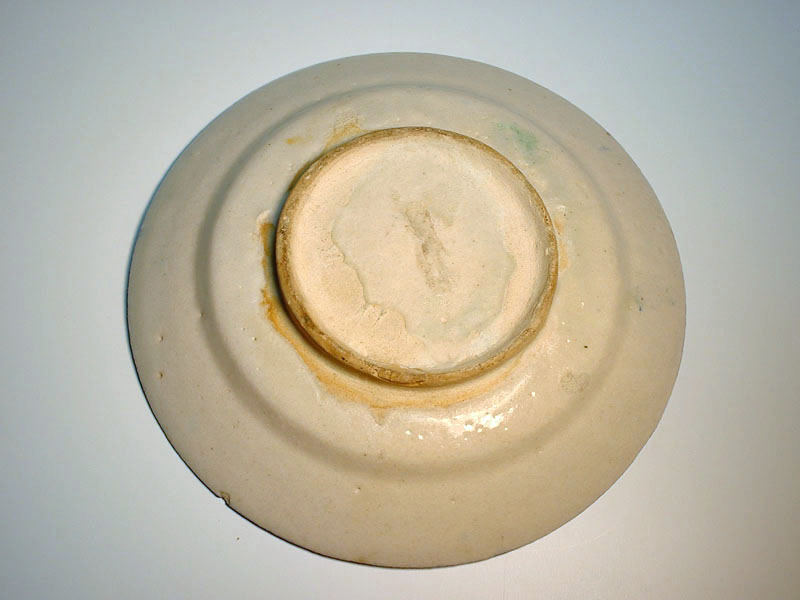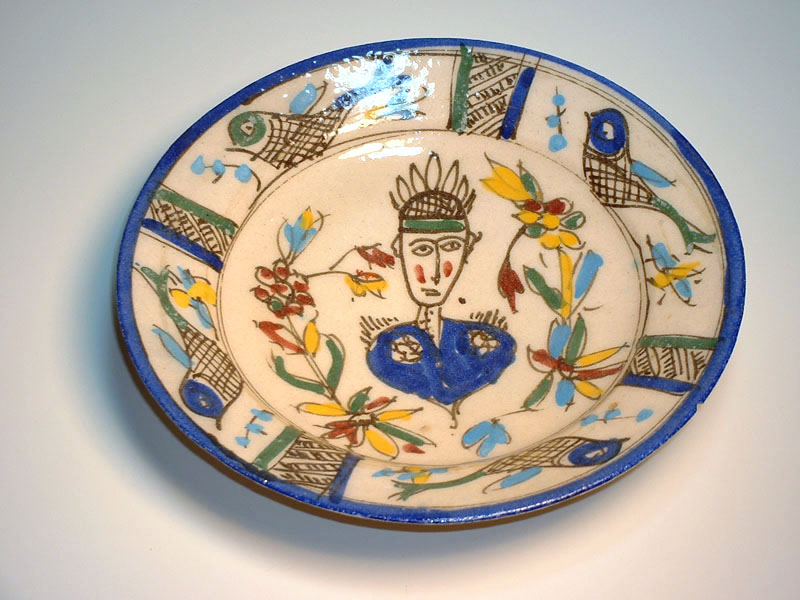A Mystery
This tin glazed plate has refused to be classified or identified for over 10 years. The front colors of the plate have always caused some suspicion while the back is convincing. The colors are exceptionally bright and vivid for a plate that stylistically wants to be a few hundred years old.
This plate is earthenware. However, unlike most earthenware from the 13th – 18th centuries where the clay is reddish or pink, it is quite white in color. This is known as buff ware.

Looking at the base, we see a very eroded foot ring. The clay appears to be fired to a lower level of vitrification. On the base we see that the tin glaze has retracted from the foot towards the center of the base and outside the ring, away from it. This is common on early tin glazed earthenware. Tin glaze was a fairly expensive material in the time frame we are considering. It was used sparingly on the reverse causing this shrinking and exposed clay body.
We see some resemblance in the way the face is rendered in early buff ware from Italy (see https://collections.vam.ac.uk/item/O138215/dish-unknown/ Note: hair, eyes, eye brow). We see a similar rendering in pieces from Nishapur, Cyprus and Egypt (see https://collections.vam.ac.uk/item/O143970/bowl/). The color pallet is completely different however. I just cannot find a contemporary rendering like this. Also, I believe this piece is slip decorated with a clear (lead) glaze over top. Not sure these very early pieces were produced this way.
It is also impossible to miss the possible native American connection, headband, feathers, but what than of the applets(?) on the shoulders?
We will continue….
Kütahya or Iznik Fritware?
Update:
Feb. 9, 2023
We are now looking at Kütahya as a possible origin and 18th century as a possible date. We are also considering Iznik. We remain concerned with the strong yellow in the pallet. Also on many, but not all, of the reference pieces, the red stands proud of the surface. Not a feature of ours. Note also the lack of turquoise on our piece.
See new references:
https://data.fitzmuseum.cam.ac.uk/id/image/media-50541
https://www.proantic.com/en/1022114-ceramic-plate-from-iznik-turkey-ottoman-17th-century.html
https://www.ceramopolis.com/?page_id=2063
https://www.proantic.com/en/1067378-ottoman-ceramic-plate-from-kutahya-from-the-18th-century.html
https://www.proantic.com/en/1067372-ottoman-ceramic-plate-from-kutahya-from-the-18th-century.html
https://www.proantic.com/en/1067377-ottoman-ceramic-plate-from-kutahya-from-the-18th-century.html
https://bilfengroup.com/en/sanat-koleksiyonu/kutahya-cini-koleksiyonu
The following is from the magazine Cornucopia ( https://www.cornucopia.net/magazine/articles/kuetahya-in-many-guises/ )
“Kütahya ceramics are easily distinguished from the more formally decorated Iznik wares. Finely potted, generally quite small pieces with a thin white body are painted in a palette of bright colours in an exuberant but sketchy style, sometimes rather unfairly described as “rustic”. New designs included quaint human figures dressed in contemporary fashions, and patterns inspired by imported Indian textiles and by Japanese and Chinese porcelains. A wide range of shapes included every type of domestic object: inkwells and pen boxes, pilgrim flasks and rosewater sprinklers, dishes and bowls. Most ubiquitous are the pots, cups and saucers used for coffee. In Ottoman documents Kütahya potters are frequently referred to as fincancı, “coffee-cup makers”.
Further investigation is needed on the fabric of this plate. While we originally suggested buff ware or buffware, we now feel it may be fritware or frit ware, also called stonepaste.
See: https://www.metmuseum.org/toah/hd/slje/hd_slje.htm
and
Iznik Fritware

